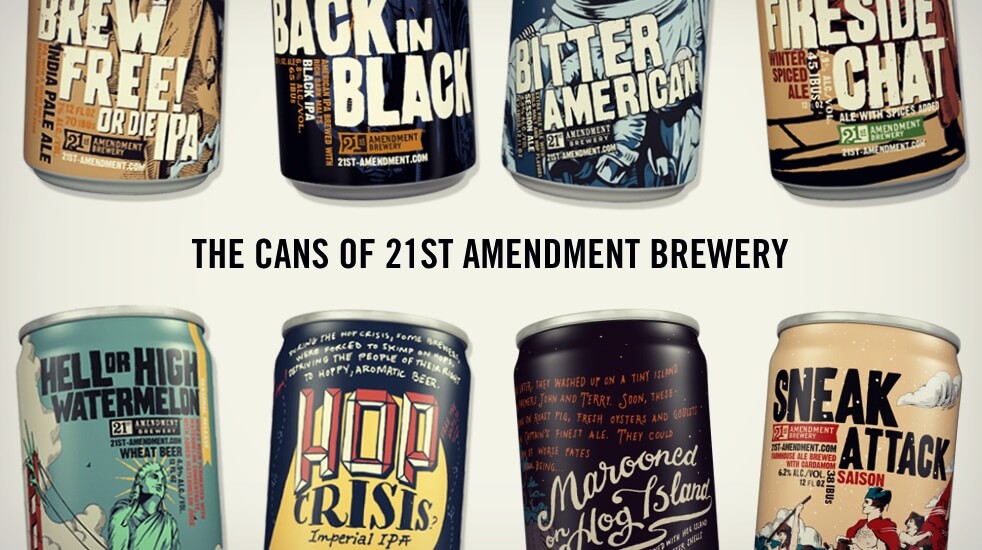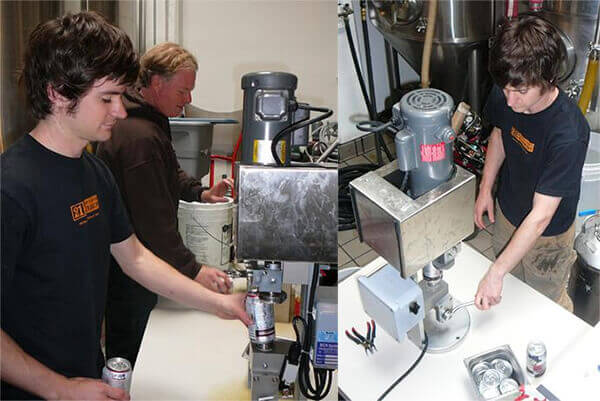
Maybe Shaun O’Sullivan was destined to put his 21st Amendment Brewery beers in cans. “I’ve always been drawn to beer cans,” O’Sullivan says. “I collected them when I was a teenager and was inspired by their captured history and artwork.”
Five years after opening his San Francisco brewpub with his business partner, Nico Freccia, O’Sullivan saw cans in a different light. “I attended the 2005 Great American Beer Festival in Denver,” he recalls, “and took an afternoon off to head to the small town of Lyons to visit Oskar Blues Brewery & Pub.”
Three years before, the tiny Colorado brewpub bought Cask’s tabletop machine and became the first US microbrewer to brew and can its own beer. “They were putting their Dale’s Pale Ale in a 12-ounce can with a new five-head filler from Cask Brewing Systems,” O’Sullivan recalls. “I was blown away — literally struck by lightning by this idea.”
When we first started canning our beer in 2006,” O’Sullivan says, “there wasn’t any other option for the small craft brewer to put their beer in cans. Cask gave us — and a lot of other brewers since then — the opportunity to put our beer in cans with the micro-canning technology they developed.
Inspired by his aluminum epiphany, O’Sullivan returned to the Bay Area and told Freccia about his fever dream to can the company’s two best-selling beers (a novel watermelon wheat and a lush IPA). “Nico thought it was the dumbest idea in the world,” he recalls. “But together we looked into all the reasons why it made sense. It’s what we all know today: portability, recyclability, energy savings in production and shipping, and a 360-degree surface to create your label and share your message.”
“We also chose cans because the idea was unique and differentiated us from beers in glass bottles. Plus we drank the ‘cans rule’ Kool-Aid from (Oskar Blues Lead Singer/Idea Man) Marty Jones. His passion really motivated us to make a go of it.”
The brewery purchased a two-head Cask filler and seamer, a manual sixpacker, and 160,000 cans from Ball Corporation and began canning it beers on May 8, 2006.
As an early adopter of canned craft beer, the brewery encountered its share of doubters. “The connotation back then,” he says, “was that canned beer was bad beer. We always said that bad beer is bad beer and a can is just a package.” O’Sullivan also believed in his cans as a novel way to engage craft beer drinkers. “We just loved our beer in a can,” he says, “and wanted to talk about it.”

The early days of canning at 21st Amendment! Photo from circa 2006.
Credit: Brookston Beer Bulletin
After a few years of successful micro-canning, 21st Amendment partnered with Minnesota’s Cold Spring Brewery to help meet its can demand. Last year 21st Amendment opened a new production brewery of its own in nearby San Leandro, and shifted over 90% of its canning effort to the new brewery. This year the brewery will produce about 110,000 barrels of beer, over 100 times the volume of its early days.
Nico thought it was the dumbest idea in the world,” O’Sullivan recalls. “But together we looked into all the reasons why it made sense. It’s what we all know today: portability, recyclability, energy savings in production and shipping, and a 360-degree surface to create your label and share your message.
“The Cask two-head filler was a stepping stone to greater and bigger things for us,” O’Sullivan says. “What started as a fun idea with no real plan for getting any bigger was the start of an incredible journey. It has taken 21st Amendment to places and a level that we never would have imagined.”
“When we first started canning our beer in 2006,” O’Sullivan says, “there wasn’t any other option for the small craft brewer to put their beer in cans. Cask gave us — and a lot of other brewers since then — the opportunity to put our beer in cans with the micro-canning technology they developed.”
